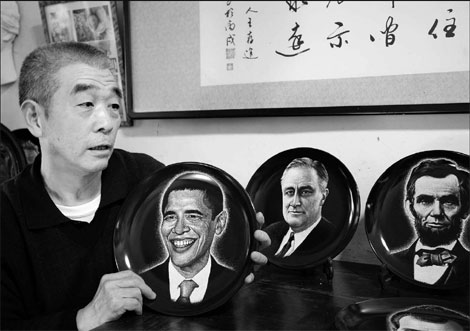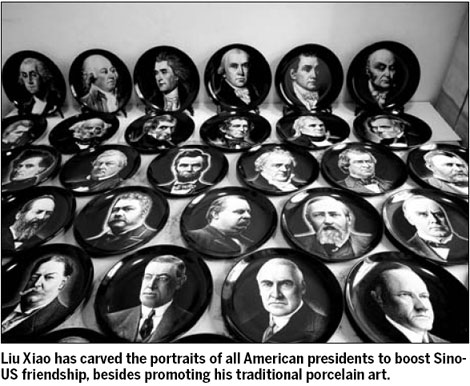Face lift for heads of state
A Shandong porcelain carver, who has done the portraits of all US presidents, says he wants to boost friendship between the two people. Ju Chuanjiang and Dai Yan report
An elderly man sitting by a table in dim light is hammering a chisel on a black porcelain plate. A picture of US president Barack Obama slowly begins to take shape.
| ?
 Liu Xiao has just finished a portrait of US president Barack Obama and wants to present the carved porcelain to him when he visits China again. Photos by Ju Chuanjiang / China Daily |
Liu Xiao, 65, of Jinan, Shandong province, says he wants to present this portrait to the American leader when he visits China again.
In three years, Liu has carved the portraits of all 44 American presidents.
"I want to boost friendship between the Chinese and Americans, besides promoting this traditional porcelain art," he says.
He takes meticulous care to do his presidential portraits: gathering information about each president and finding representative photos and choosing the best porcelain plates, before starting the job.
Liu begins with the eyes, which, he says, reflects a person's soul. Carving the expressions and attire call for particular care, as Liu has just a few centimeters of space to work with.
"Carving porcelain is like doing embroidery. It requires great patience and perseverance. The slightest mistake could ruin the entire work," he says.
Carved porcelain is a Chinese folk art that dates back to the Qin Dynasty (221-207 BC), but saw its heyday during the Tang Dynasty (AD 618-907).
Liu's carved portraits include those of Chinese leaders and world celebrities such as Albert Einstein. In 2005, when China celebrated the centennial of its film industry, Liu came up with the portraits of 24 film stars.
"I spent more than three months on former chairman Mao Zedong's portrait. I didn't allow myself a single mistake," Liu says, pointing at his favorite piece that shows Mao at the country's founding ceremony in 1949.
Liu developed an early interest in painting and photography, but never got a chance at college. After completing his army service, he joined a factory making heavy machines. Thanks to his love of art, he was appointed art teacher in the factory's school.
In the early 1990s, Liu chanced upon some carved porcelain at an art market in Jinan and was fascinated.
He began carving on bottles, glass and bricks, to save money. One winter, when the flowers had all withered, Liu picked up the ceramic plates kept under the pots to carve on them.
| ?
 |
He experimented with a variety of drawing techniques and plates of different colors. He found that black and dark blue plates were ideal for creating three-dimensional and lifelike images.
"I never use ink or color. The thickness of the glaze is enough to give the portrait layers. This makes my works different from those by others," Liu says.
"He is crazy about carving porcelain," says his wife Jiang Xiaodong.
To find good plates, the couple regularly visits Zibo, a Shandong city famous for its porcelain.
Other people carve porcelain to sell, but Liu never sells his works, no matter how much he is offered. Jiang says they bought their refrigerator in 2000 and a color TV only in 2006. Their rented apartment is simply furnished with two simple beds and some wooden benches.
But Jiang understands her husband's passion for his craft. While taking care of their grandchildren, she also helps him manage a blog, which has attracted many young people eager to learn this art form.
A winner of many awards, Liu was named a "master of folk arts" in Shandong in 2007.
Asked what he wants to do with his creations, he says: "I wish to donate them for charity."






















